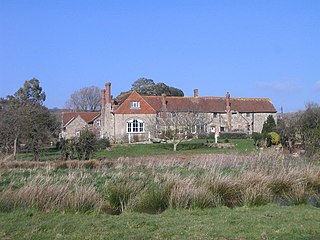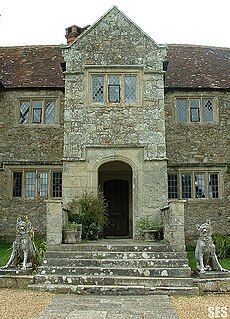Huffingford Manor (also Hovyngford) is a manor house on the Isle of Wight, situated in the parish of Arreton.

The Isle of Wight is a county and the largest and second-most populous island in England. It is in the English Channel, between 2 and 5 miles off the coast of Hampshire, separated by the Solent. The island has resorts that have been holiday destinations since Victorian times, and is known for its mild climate, coastal scenery, and verdant landscape of fields, downland and chines.

Arreton is a village and civil parish in the central eastern part of the Isle of Wight, England. It is about 3 miles south east of Newport.
Beyond the mill there is practically no land now to correspond with the early holding, which doubtless included what is now known as Blackwater. The ford still exists by the side of the bridge, built in 1776, where the ancient road to Newport turns to the westward. If the Domesday entry Huncheford is taken as representing Huffingford, there was a mill there in early days, and a family seems in the 13th and 14th centuries to have taken its name from the holding. [1] William of Huffingford held a quarter fee there towards the end of the 13th century under John de Lisle. A Walter de Huffingford was witness to a grant of land at Whitcombe in 1323. William le Martre held another quarter fee there under the manor of Gatcombe in 1293–4, to be succeeded by John le Martre in 1346 and in 1428 by Isabel Martre, who had apparently married — Hughes, as she is returned for aid three years later as Isabel Hughes. [1] In 1500 John Clarke, a Lymington butcher, owned land in Huffingford, which is the last mention of the holding under that name. The mill has had various owners, being at one time used for lacemaking. As of 1912 it was owned by Mrs. George Mearman. [1]

Newport is a civil parish and the county town of the Isle of Wight, an island off the south coast of England. The civil parish had a population of 23,957 at the time of the 2001 census, which rose to 25,496 at the 2011 census. The town lies slightly to the north of the centre of the Island. It has a quay at the head of the navigable section of the River Medina, which flows northward to Cowes and the Solent.

Gatcombe is a village in the civil parish of Chillerton and Gatcombe, on the Isle of Wight. It is located about two and a half miles south of Newport, in the centre of the island.

Lymington is a port town on the west bank of the Lymington River on the Solent, in the New Forest district of Hampshire, England. It faces Yarmouth, Isle of Wight, to which there is a car ferry service operated by Wightlink. It is within the civil parish of Lymington and Pennington.




